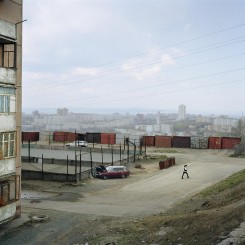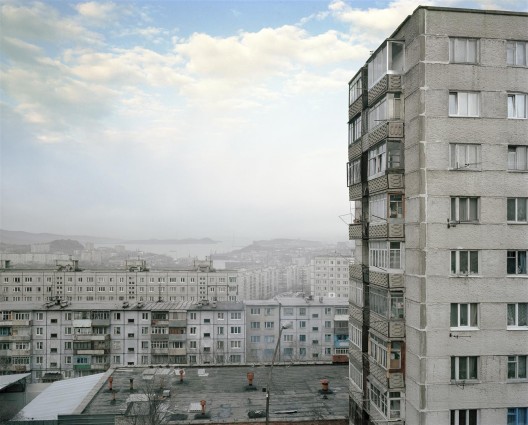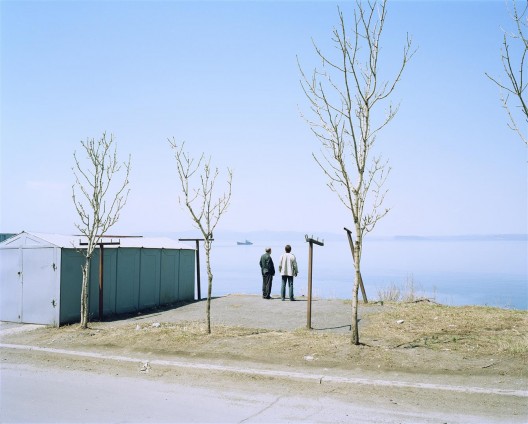This piece is included in Ran Dian’s print magazine, issue 3 (Spring 2016)
As Russia’s main outpost in the Far East, Vladivostok holds a strategic position that has been both a blessing and a curse for its development, not least culturally. While its residents do try to take advantage of their proximity to the cultures and economies of China, Korea, and Japan, the state thwarts this openness with attempts to push the city in the opposite direction. During Soviet times, the city, a major naval base, was “closed.” The drastic political turn taking place in Russia over the last decade might possibly lead to a return to such enclosure.
For a long time, local artists were cut off from news about art and culture in the rest of the world. Though Soviet books on modern art (written from an absolutely anti-modernist point of view) contained some textual and—more importantly—visual information, their narratives usually ended with Pop art. The European-facing part of the country was somewhat better off: the “American National Exhibition” in Sokolniki Park in Moscow in 1959 stimulated many Moscow artists and gave birth to new art movements. The show afforded them contact with artists and other visitors from abroad as well as information about Western contemporary art; news also traveled outward about the “non-official” Russian art scene. Yet residents of Vladivostok were almost completely deprived of such encounters. And when the city was “opened,” things went rather awry. Doctors recommend not gorging oneself after a long period of starvation and malnourishment, but the artists, in their ravenous hunger for accessible culture, broke this rule. Some, like Yury Sobchenko, Gennady Omelchenko, Alexander Pyrkov, and Victor Fedorov, became obsessed, with no trace of irony, with Paul Cézanne, Henri Matisse, Pablo Picasso, Paul Klee, Mark Rothko, or the American Minimalists, all of whom had by the late twentieth century become canonical—and outmoded. This was inevitable, a result of the delayed consumption of art history that had been missing throughout the Soviet period. (Yet sometimes, as in Fedor Morozov’s work, the tribute to great modernist figures could be truly masterful.)
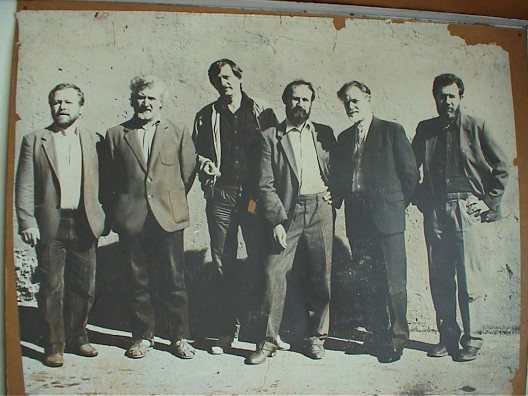
“艺术组海参崴”(由左至右):Valery Nenazhibin, Viktor Shlikht, Alexander Pyrkov, Yuri Sobchenko, Ryurik Tushkin, Fyodor Morozov, 1988(图片由Zarya当代艺术中心提供)/Artgroup Vladivostok (from left to right): Valery Nenazhibin, Viktor Shlikht, Alexander Pyrkov, Yuri Sobchenko, Ryurik Tushkin, Fyodor Morozov, 1988 (courtesy ZARYA Center for Contemporary Art)
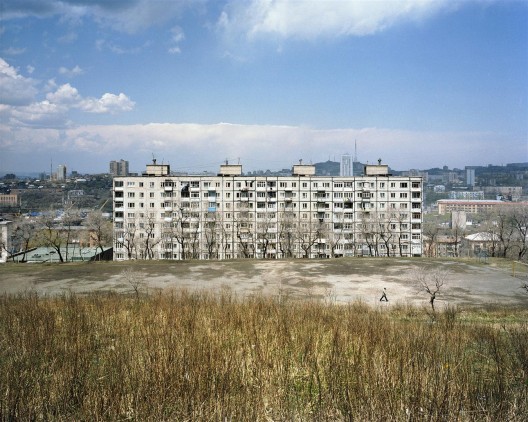
亚历山大·格朗斯基,《少于一》系列,摄影,2006–2009(图片由艺术家提供)/ Alexander Gronsky, Less Than One series, photography, 2006–2009 (courtesy the artist)
The artists who escaped this dangerous trap found themselves enmeshed in another one. Geographically, Vladivostok’s position presupposes a different attitude toward the world’s cultural topography. If Moscovites and Peterburzhtsy swing toward cultural poles in Europe and North America, people from eastern Russia, especially Vladivostok, look to different cultural centers: such as Australia, Korea, or China. Younger generations might easily change this orientation, but the same cannot be said about cultural workers who have lived most of their lives in the USSR (and frankly, even Moscow conceptualists have had problems adapting to post-Soviet conditions). Since Perestroika (the political reforms of the 1980s), a number of artists from Vladivostok have been exhibiting in galleries and museums in China and on the West Coast of the United States, even selling artworks to Chinese and American collectors. The hitch is that many of these galleries and museums have turned out to be highly questionable: money is spent, but the artworks sold are often “lost” to unknown collections. Apparently only a local branch of the Union of Artists—an organization left over from the Soviet past, a shadow side of the Russian art scene—is satisfied with the situation, in large part because some of its members have found ways to make a living. But most artists who are not bureaucrats from the Union feel quite isolated from the Russian “mainland” today, as opposed to the situation in late Soviet times and the 1990s, when some of them had strong connections with the Moscow art scene. Alexander Gorodny—in the process of rebuilding Art-Etazh as a state-funded art collection after having been an artist-run “gallery” with a collection—confesses, for instance, that he now has much more limited means to get to the European part of Russia. Many older artists, too, have experienced reduced contact with institutions in neighboring countries.
In Russian cultural institutions, and museums are no exception, it is depressingly common for building design to prevail while everything else occupies a secondary role, following the neoliberal managerial turn in the cultural sphere during the 2000s, first in Moscow and then in other regions. A really awfully managed museum with subpar exhibitions may look good because of a nice café, a big bookstore, and accurate explanations in the wall labels. Yet even in this state of things, some cultural initiatives do their best to work in and for the region. Since the appointment of a new director, Victor Shalay, in 2010, the Arseniev State Museum, the main ethnographic institution in Vladivostok, has been rejuvenated. In contrast to many Russian institutions, Shalay progressively improved on both the “meat” and the “dressing,” so to speak. Having reshuffled the staff, he then turned the exhibitions from hermetically plugged bottles with fixed content approved in official papers into a lively complex of objects ready to be reinstalled and oriented to the audience. For a Russian museum, the change has been startling.
Another initiative of this kind is Zarya, a private, non-commercial institution established in 2013 on the outskirts of Vladivostok. Its owner, Alexander Mechetin, is a vodka tycoon from the Russian Far East who lives in Moscow. With its Moscow-based advisory board approving decisions about finances and exhibition policies, it was not altogether unexpected that Zarya started as a “colonial” project. It served, for example, as a site for readymade projects such as Tretyakov Gallery’s “Decoration of the Beautiful”, an exhibition dedicated to the dialectics of kitsch and elitism in contemporary art, a small video retrospective of the work of Francis Alÿs, and a posthumous retrospective devoted to the well-known Russian street artist Pasha 183, which showed also at the Moscow Museum of Modern Art. Such content filled precise cultural niches, none of which were related to Vladivostok.
Zarya began transforming itself at the end of 2014, when the art center was strengthened with an artist residency. Designed for nonresidents of Vladivostok, the program has brought in artists from Moscow and abroad to work with the local context. Another positive step was made when Zarya’s chief curator, Alisa Bagdonayte, steered the institution toward a major research project on local contemporary art from the 1960s through the present, resulting in the ongoing exhibition “Rebels at the Edge”; for this she collaborated with the local private gallery Arka, whose director, Vera Glazkova, is a co-curator of the show, and with Primorsky State Picture Gallery. “Rebels at the Edge” presents key figures of the 1960s and 1970s who fell from view in the 1980s and 1990s but were revived in the 2000s, for instance the mystifier Pavel Shugurov, the photo-activist Mikhail Pavin, and Alexander Kiryakhno, a man obsessed with erotic imagery. As an attempt to rewrite the history of Vladivostok’s art scene, this has raised some critical ire, but it is a path that Zarya deliberately aims to tread. Somewhat symbolically, zarya means “dawn” in Russian.
The challenges are still daunting in Vladivostok. The local system of institutions is weak: one private gallery, one temporarily closed artist-run collection (Art-Etazh), and one state gallery (art museum) that owns great works but has many difficulties in displaying them. The city has also managed to get a new art center, Zarya, with the budget to organize risky projects. The younger generation of artists and curators may still be trying to leave, but the transformations happening today may bear fruit and, one day, stem the exodus.
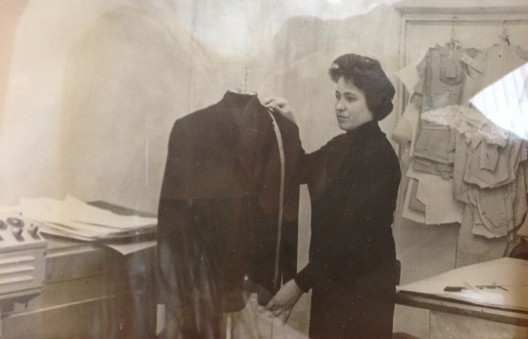
Zarya制衣厂的一位设计师,1960年代(图片由Zarya当代艺术中心提供)/Designer at garment factory ZARYA, 1960s (courtesy ZARYA Center for Contemporary Art)
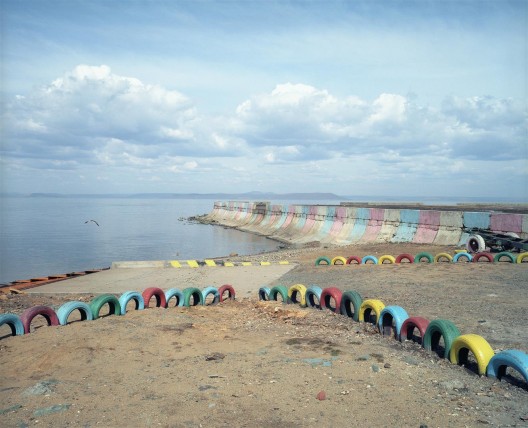
亚历山大·格朗斯基,《少于一》系列,摄影,2006–2009(图片由艺术家提供)/ Alexander Gronsky, Less Than One series, photography, 2006–2009 (courtesy the artist)
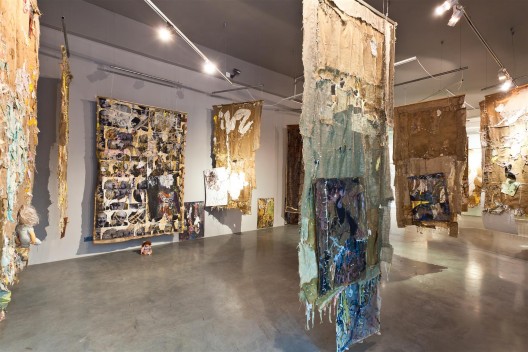
亚历山大·基尔雅克诺,《无题》,装置,“在边缘叛逆:海参崴1960–2010年代当代艺术”群展(图片由
Zarya 当代艺术中心提供)/ Alexander Kiryakhno, “Untitled”, installation, at the exhibition “Rebels at the Edge: Contemporary Art in Vladivostok, 1960s–2010s” (courtesy ZARYA Center for Contemporary Art)



